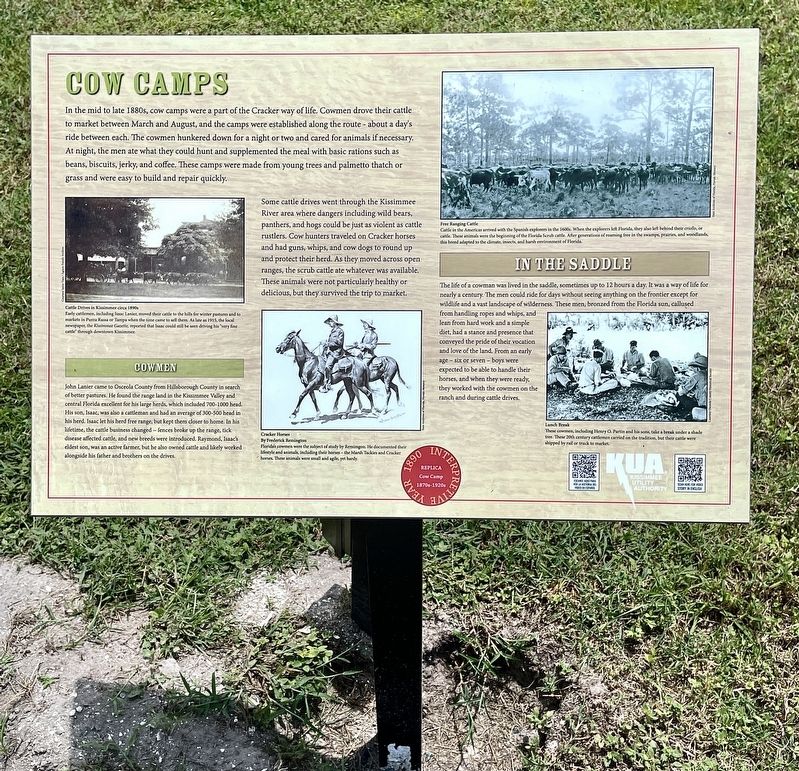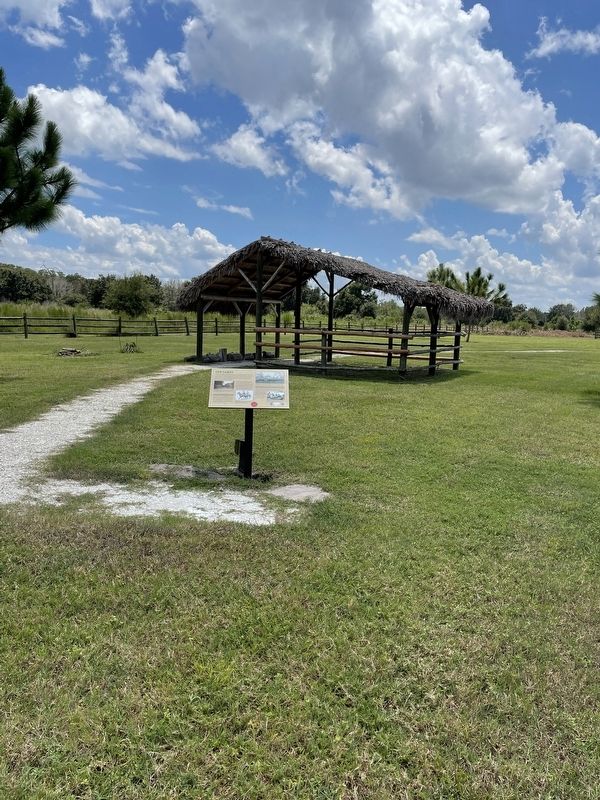Kissimmee in Osceola County, Florida — The American South (South Atlantic)
Cow Camps
— Pioneer Village at Shingle Creek —
Some cattle drives went through the Kissimmee River area where dangers including wild bears, panthers, and hogs could be just as violent as cattle rustlers. Cow hunters traveled on Cracker horses and had guns, whips, and cow dogs to round up and protect their herd. As they moved across open ranges, the scrub cattle ate whatever was available. These animals were not particularly healthy or delicious, but they survived the trip to market.
Cowmen
John Lanier came to Osceola County from Hillsborough County in search of better pastures. He found the range land in the Kissimmee Valley and central Florida excellent for his large herds, which included 700-1000 head. His son, Isaac, was also a cattleman and had an average of 300-500 head in his herd. Isaac let his heard free range, but kept them closer to home. In his lifetime, the cattle business changed — fences broke up the range, tick disease affected cattle, and new breeds were introduced. Raymond Issack’s eldest son, was an active farmer, but he also owned cattle and likely worked alongside his father and brothers on the drives.
In the Saddle
The life of a cowman was lived in the saddle, sometimes up to 12 hours a day. It was a way of life for nearly a century. The men could ride for days without seeing anything on the frontier except for wildlife and a vast landscape of wilderness, These men, bronzed from the Florida sun, callused from handling ropes and whips, and lean from hard work and a simple diet, had a stance and presence that conveyed the pride of their vocation and love of the land from an early age - six or seven - boys were expected to be able to handle their horses, and when they were ready, they worked with the cowmen on the ranch and during cattle drives.
(captions )
Cattle Drives in Kissimmee circa 1890s
Early cattlemen, including Isaac Lanier, moved their cattle to the hills for winter pastures and to markets in Punta Rassa or Tampa when the time came to sell them. As late as 1913, the local newspaper, the “Kissimmee Gazette” reported that Isaac could still be seen driving his “very fine cattle’ through downtown Kissimmee.
Cracker Horses
by Frederick Remington Florida’s cowmen were the subject of study by Remington. He documented their lifestyle and animals, including their horses — the Marsh Tackies and Cracker horses. These animals were small and agile, yet hardy.
Photo courtesy State Archives of Florida, Florida Memory
Free Ranging Cattle
Cattle in the Americas arrived with the Spanish explorers in the 1600s. When the explorers Ieft Florida, they also left behind their criollo, or cattle. These animals were the beginning of the Florida Scrub cattle. After generations of roaming free in the swamps, prairies, and woodlands, this breed adapted to the climate, insects, and harsh environment of Florida.
Photo courtesy State Archives of Florida, Florida Memory
Lunch Break
These cowmen, including Henry O. Partin and his sons, take a break under a shade tree. These 20th century cattlemen carried on the tradition, but their cattle were shipped by rail or truck to market.
Photo courtesy State Archives of Florida, Florida Memory
Erected by City of Kissimmee and Osceola County.
Topics. This historical marker is listed in these topic lists: Agriculture • Animals • Industry & Commerce • Settlements & Settlers.
Location. 28° 19.102′ N, 81° 27.307′ W. Marker is in Kissimmee, Florida, in Osceola County. Marker can be reached from Babb Road, 0.2 miles north of Princess Lane. Marker located within the Pioneer Village at Shingle Creek. Touch for map. Marker is at or near this postal address: 2491 Babb Road, Kissimmee FL 34746, United States of America. Touch for directions.
Other nearby markers. At least 8 other markers are within walking distance of this marker. Hide Traders (a few steps from this marker); Seminole Settlement: Life on Higher Ground (within shouting distance of this marker); Seminole Diet (within shouting distance of this marker); Radcliffe Cadman Bros. Packing House (within shouting distance of this marker); Cadman Kitchen (within shouting distance of this marker); A British Officer Finds Paradise in Florida (about 300 feet away, measured in a direct line); Bunk House (about 300 feet away); A General Store (about 300 feet away). Touch for a list and map of all markers in Kissimmee.
Also see . . . Pioneer Village at Shingle Creek. (Submitted on September 3, 2022, by Brandon D Cross of Flagler Beach, Florida.)
Credits. This page was last revised on April 13, 2023. It was originally submitted on September 3, 2022, by Brandon D Cross of Flagler Beach, Florida. This page has been viewed 105 times since then and 13 times this year. Last updated on April 12, 2023, by Steven Owens of Lake Alfred, Florida. Photos: 1, 2. submitted on September 3, 2022, by Brandon D Cross of Flagler Beach, Florida. • Bernard Fisher was the editor who published this page.

